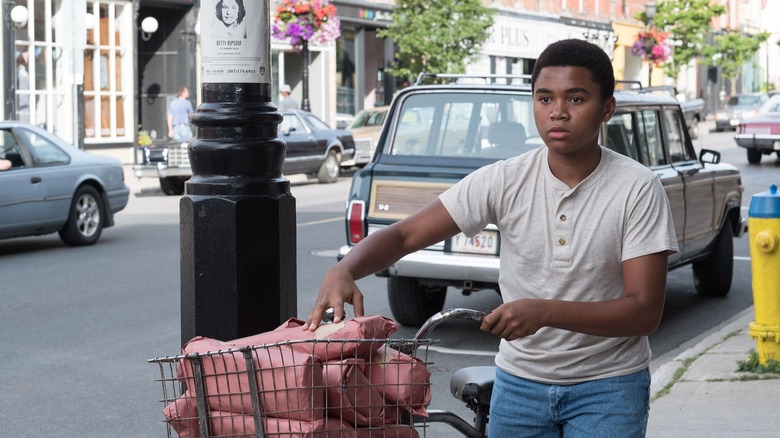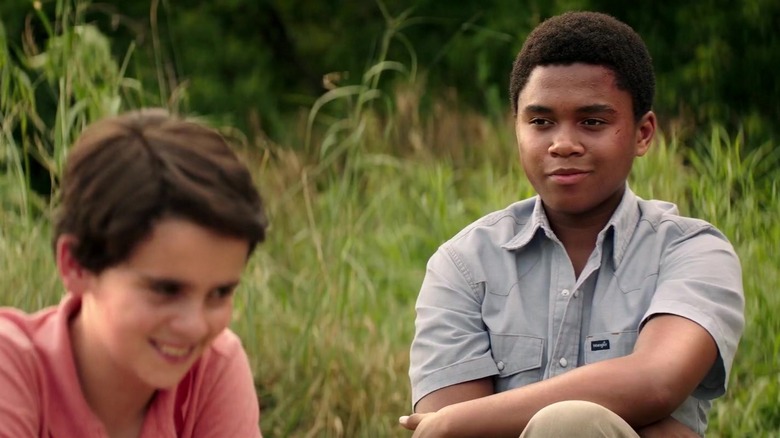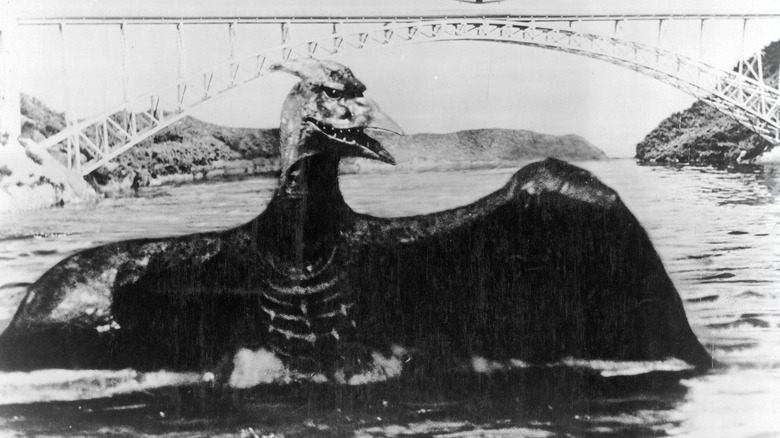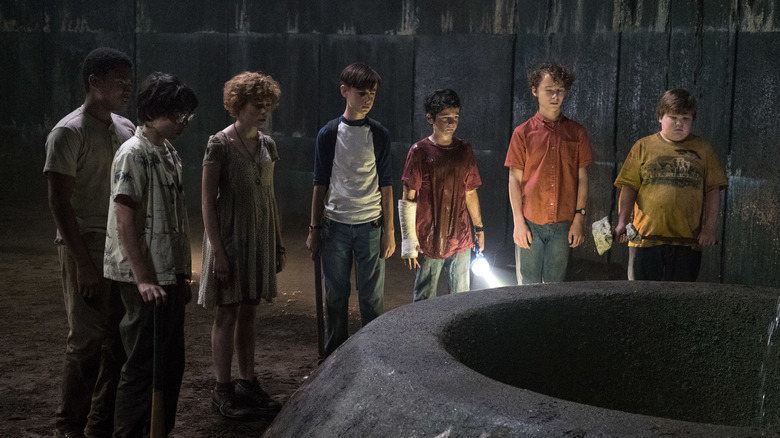One Of Mike Hanlon's Best Scenes In Stephen King's IT Never Made It On Screen
Although 2017's "IT" was released to positive audience and critical reception (even King himself was a fan), it's definitely a movie that struggles to adapt its source material. Stephen King's "IT" is around 1,200 pages long, a story that probably would've been a better fit for a TV show. Despite the smart decision to divide the book into two films, the first covering the characters' childhood storyline and the second covering their adulthood, the first movie still couldn't quite find the time make sure its seven main characters each made an impact. While characters like Richie (Finn Wolfhard) and Eddie (Jack Dylan Grazer) made strong impressions, others like Bill (Jaeden Martell) and Stan (Wyatt Oleff) faded into the background. Bill was the leader of the gang in the book, but you wouldn't really pick up on that at all from the first movie.
It's Mike Hanlon's (Chosen Jacobs) character, however, who is hurt the most by the limits of a standard movie runtime. In the book, Mike is a constant presence the whole way through. He's the only character who stays in the town of Derry as an adult, so he's the one who breaks the news to the other characters when It comes back. He's the most knowledgeable of Derry's long history of child disappearances and mass tragedies, and how It played a role in them. He's also the only character who gets a first-person point of view in the book's interlude sections.
Mike's lack of presence
The problem stems from the childhood sections of the novel, where Mike is the last to join the group. Being socially separated from the other characters not only by his race but by the fact that he goes to a different school and lives on a farm on the outskirts of the town, it takes over 600 pages before he and the others become friends. This doesn't feel like too long of a wait, thanks to his heavy presence in the book's adult storyline and in the interludes, but it certainly feels strange in a movie where none of that is included.
To address the pacing issues this would cause for the movie, most of Mike's backstory is cut. His struggles with being one of the only Black kids in the entire town are rarely touched upon in the film, and even his role as the group's historian is given over to another character. The movie even changes the scene where Mike encounters It for the first time, removing one of the most unique and terrifying moments in the whole novel.
Pennywise the bird
Before Mike's first encounter with It in the novel, he's thinking of a movie he's watched the previous night with his father — the 1956 Japanese horror movie "Rodan," which is all about a giant pterodactyl terrorizing Japan. Mike thinks about how the movie "seemed like great fun at the time," but now that he's all alone, "it didn't seem so funny now." It's a moment that really highlights a relatable feeling most people have from their childhood, of enjoying a movie while watching it with friends and family who aren't scared, but having scenes from that movie haunt you long afterward.
Soon after he reminisces about the movie, Mike comes across a giant bird in real life. From chapter six, part five of the novel:
"Its scaly talons were a dusky orange. Its beating wings, each more than ten feet across, blew the scraggy timothy grass this way and that, patternlessly, like the wind generated by helicopter rotors. It uttered a buzzing, chirruping scream. A few loose feathers slipped from its wings and spiraled back down into the cellarhold."
Mike remarks that "the bird did not look like Rodan, but he sensed it was the spirit of Rodan, risen from the cellarhold of the Kitchener Ironworks like a horrible bird-in-a-box." This bird makes a valiant effort to eat Mike alive, but Mike throws pieces of broken tiles at it until he hits it in the eye. "'Get out of here!' Mike cried. 'I'm going to keep hitting you until you get out of here, I swear to God I will!'"
Surprisingly, the bird listens and ends up flying away. Mike walks back home and, by the time he meets the rest of the gang, has started doubting if the incident ever actually happened. The characters quickly piece together that the bird was It, taking the form that would scare Mike the most. While the movie seems most interested in exploring It in the Pennywise the Clown form, the bird scene is an example of how the forms It takes in the book are a lot more varied, and a lot more creative.
The downsides of cutting the scene
Mike's first encounter with It in the movie is changed to him seeing a vision of burnt hands reaching out from a building's locked door, referencing how, in the movie, his parents died in a house fire and he had witnessed them burning to death. While understandable given the movie's limited runtime, it's a disappointing change. Not only does it remove Mike's loving relationship with his parents (unique in that he's one of the only characters with parents who aren't abusive or negligent in some way), but it also removes one of Mike's main contributions to the plot. In the book, it's Mike's telling his friends about how he fought off the bird that gives Bill the idea of using silver bullets.
The scene also serves as one of the first hints of what the kids would really need to do to scare It off: not give in to the fear It's trying to provoke. After all, it's not the bird getting its eye ruptured that makes it go away, but Mike's decision to fight back instead of trying to run. Mike's first encounter in the movie is so quick, and Mike is never forced to react to what's happening in the same way he did in the book, so the moment where he fights back (both a character-defining moment and great foreshadowing) never occurs.
Overall, 2017's "IT" is a pretty fun movie that did an admirable job condensing its massive source material into a comprehensible 135-minute story. The slow build-up of the bird scene in the book, (not to mention the necessary context of Mike having just seen "Rodan") likely would've taken up a lot of screentime in a movie that was already pretty long for a horror film. It makes sense why they cut it, but man, it would've been nice to see one of the most memorable moments from the book shown on the big screen.



